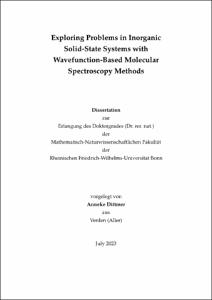Exploring Problems in Inorganic Solid-State Systems with Wavefunction-Based Molecular Spectroscopy Methods

Exploring Problems in Inorganic Solid-State Systems with Wavefunction-Based Molecular Spectroscopy Methods

| dc.contributor.advisor | Neese, Frank | |
| dc.contributor.author | Dittmer, Anneke | |
| dc.date.accessioned | 2024-04-23T08:12:26Z | |
| dc.date.available | 2024-04-23T08:12:26Z | |
| dc.date.issued | 23.04.2024 | |
| dc.identifier.uri | https://hdl.handle.net/20.500.11811/11508 | |
| dc.description.abstract | The present work explores the possibilities of computational protocols that combine an electrostatic embedding approach to model inorganic crystalline solid-state systems with molecular theory methods for accurate calculation of spectroscopic properties. It highlights the potential of multistep protocols that combine methods ranging from DFT to single- and multireference wavefunction-based methods to explore and understand spectroscopic observations at the theoretical level.
A generalized protocol for modeling bulk properties of inorganic solid-state systems using an electrostatic embedding approach within the ORCA program suite is presented. The protocol involves applying a quantum mechanical method to a specific quantum cluster that represents a part of a solid-state system. The quantum cluster is embedded in a point charge field that accounts for the long-range electrostatic effects of the solid-state system. This approach allows the quantum cluster to operate as if it were in the bulk of a solid-state system. In particular, a newly developed automated electrostatic embedding approach within the QM/MM framework in ORCA, called Ionic-Crystal-QM/MM, is presented. Two benchmark studies are performed to evaluate the applicability of the electrostatic embedding approach and molecular methods for the calculation of bulk properties of inorganic solid-state systems. The first study focuses on the calculation of NMR nuclear shielding constants using DFT functionals and MP2. The second study investigates the calculation of band gaps using TD-DFT with a variety of DFT functionals and bt-PNO-STEOM-CCSD. Both studies show that the electrostatic embedding approach gives robust results as long as the quantum cluster is carefully embedded in a sufficiently large and charge-optimized point charge field and the quantum cluster itself is converged with respect to the desired property. When this is the case, the molecular methods can obtain the calculated bulk properties with an accuracy comparable to that expected for the calculation of equivalent molecular properties using the same methods. In addition, the band gap study gives results comparable to those obtained from periodic studies. The accuracy of the calculated properties compared to the experimental data increases with the level of theory used and gives a satisfactory agreement with the experimental results for the applied post-Hartree-Fock methods in both cases. With the developed and tested electrostatic embedding approach, the antiferromagnetic cobalt oxide Co(II,III)3O4, a spinel structure with tetrahedrally coordinated Co(II) and octahedrally coordinated Co(III) sites, is studied in terms of its band gaps and Kβ1,3/Kβ' mainline and Kβ2,5/Kβ'' valence-to-core (VtC) X-ray emission (XES) spectra. To gain a better understanding, the antiferromagnetic derivative Al2Co(II)O4 and the diamagnetic derivative Co(III)2ZnO4 are also studied. Both studies combine different DFT and multiconfiguration/multireference wavefunction-based approaches. The latter class of methods is able to explicitly treat the antiferromagnetic coupling within the materials by considering "neutral" and "ionic" antiferromagnetic states. Each study provides significant insight into the properties of the cobalt oxides under investigation. For example, it is found that the band gaps of Co(II,III)3O4 are dominated by ligand field transitions local to the antiferromagnetically coupled Co(II) sites. The Kβ1,3/Kβ' mainline XES study shows that significant intensity contributions to the spectra can originate from final states with electron excitations within the 3d orbitals, and the Kβ2,5/Kβ'' XES study shows that the presence of "ionic" antiferromagnetic states can lead to double peak features in the spectrum. | en |
| dc.language.iso | eng | |
| dc.rights | In Copyright | |
| dc.rights.uri | http://rightsstatements.org/vocab/InC/1.0/ | |
| dc.subject | Ionic-Crystal-QM/MM | |
| dc.subject | electrostatic embedding schemes | |
| dc.subject | solid-state spectroscopy | |
| dc.subject | theoretical spectroscopy | |
| dc.subject | band gaps | |
| dc.subject | X-Ray emission spectroscopy | |
| dc.subject | solid-state NMR | |
| dc.subject.ddc | 540 Chemie | |
| dc.title | Exploring Problems in Inorganic Solid-State Systems with Wavefunction-Based Molecular Spectroscopy Methods | |
| dc.type | Dissertation oder Habilitation | |
| dc.identifier.doi | https://doi.org/10.48565/bonndoc-272 | |
| dc.publisher.name | Universitäts- und Landesbibliothek Bonn | |
| dc.publisher.location | Bonn | |
| dc.rights.accessRights | openAccess | |
| dc.identifier.urn | https://nbn-resolving.org/urn:nbn:de:hbz:5-75689 | |
| dc.relation.doi | https://doi.org/10.1021/acs.inorgchem.9b00994 | |
| dc.relation.doi | https://doi.org/10.1051/epjconf/202024600006 | |
| dc.relation.doi | https://doi.org/10.1021/acs.jctc.0c00067 | |
| ulbbn.pubtype | Erstveröffentlichung | |
| ulbbnediss.affiliation.name | Rheinische Friedrich-Wilhelms-Universität Bonn | |
| ulbbnediss.affiliation.location | Bonn | |
| ulbbnediss.thesis.level | Dissertation | |
| ulbbnediss.dissID | 7568 | |
| ulbbnediss.date.accepted | 28.11.2023 | |
| ulbbnediss.institute.other | Max-Planck-Institut für Kohlenforschung (Mülheim an der Ruhr) | |
| ulbbnediss.fakultaet | Mathematisch-Naturwissenschaftliche Fakultät | |
| dc.contributor.coReferee | Bredow, Thomas |
Dateien zu dieser Ressource
Das Dokument erscheint in:
-
E-Dissertationen (4384)




